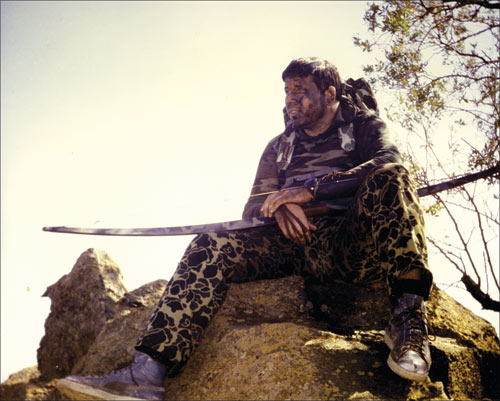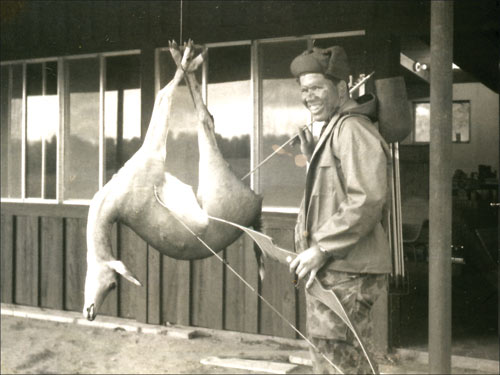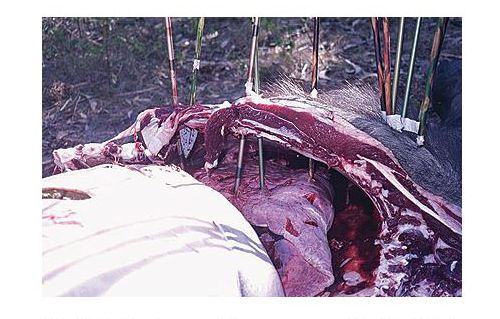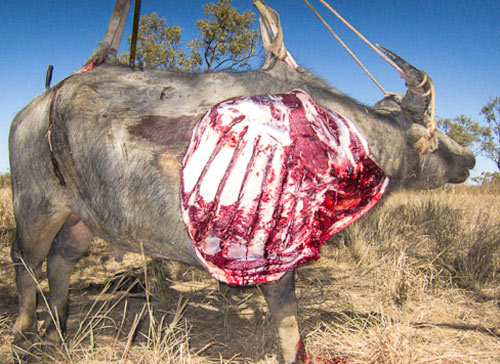By Dr. Ed Ashby – Re-published courtesy of Grizzly Stik
Editors Note: Though Dr. Ashby produced his series of papers on Arrow Lethality over twenty years ago, and technology has vastly changed, it still remains — along with his other works — some of the most comprehensive and unbiased collections of data on arrow and broadhead performance in existence. Whether you are new to bowhunting and looking for the most ethical system or an old hand looking to try something different, this five-part series is worth following.
Volumes of data on terminal ballistics — what happens from the moment of impact — have been written for every conceivable rifle and bullet combination in existence. Very little such information exists for archery equipment.
In today’s hunting world, where politics frequently affect hunting opportunities more than game populations do, such information becomes highly important. Many would see all hunting, of all forms, banned worldwide. Logic and factual information will never sway their opinion. Factual information, leading to sound hunting policies that support sustainable utilization of the renewable resource through the humane taking of surplus game can, however, do much to influence the majority of the population, those who are neither pro nor anti-hunting.
Bowhunting has long been a target of the anti-hunting movement. It has been portrayed as inhumane and ineffective. Pictures of animals riddled with arrows escaping to die a lingering death are depicted by the devoted anti-hunter. The only defense against such false information is verifiable facts, yet little has been done to collect and disseminate the information needed by bowhunters to permit them to make wise choices in equipment and techniques used to humanely take game. The end result has been a proliferation of equipment and misinformation which, rather than making bowhunting more effective, has actually produced an increase in the wounding rate of game in many instances. Such mistakes by the bowhunting public play directly into the hands of the anti-hunters.
Through this series of articles, we will look at what information, based on empirical data, is currently available. Much of what is presented here is from research in which I have been personally involved. Every project with which I have been associated has been independent of any funding or subsidy by any manufacturer, distributor or retailer of archery equipment. All, save the Natal Study, have been personally funded.
The Natal Study was conducted under the auspices of the Natal Parks Board of South Africa. I do not hold, nor have I ever held, any affiliation with any archery company, manufacturer or firm. All the following research information has appeared in detailed form in various publications in the U.S., Australia, and Europe. Much has been re-tested and verified by other independent researchers in the field of wildlife management. Still more awaits independent verification.
Bowhunting remains under close scrutiny in Africa — as elsewhere. Least decision makers be forced to rely on incidental information only, as much hard data as possible must be made available. The purpose of presenting this information is to disseminate as widely as possible what information I have available. All available information, favorable and unfavorable, needs to be publicly available to individual bowhunters, the general public, government officials, and other researchers. This permits others to examine and experiment with the information and opens channels of thought and communication for further investigation and forms a basis for making informed decisions, both individually and collectively.
The question of broadhead effectiveness and the lethality of broadhead tipped arrows has become almost an obsession with me through the years. As I long ago discovered, it is a highly complex and often perplexing study. To this study, I have devoted many years and significant personal funds. My professional training has proved of great value in the investigation of wound channels. Being in addition to a bowhunter, a hunter with firearms, I have also made detailed study of wound channels from various bullets from many calibers of rifles and handguns. This has helped form a basis of comparison.
Several decades ago, when I first began bowhunting, it was a rare occasion when any bowhunter in our camp hit a big game animal and failed to recover it. As the years went by, I felt that the number of animals being hit by bowhunters and not recovered was escalating. Eventually, I became certain that the wounding rate was increasing. Why? What was causing this increase in hit and lost game? The question intrigued me. As I delved into the subject, I found that researchers in the field of wildlife management had already detected the same trend (See Graph XV and “Collateral Data” Table). It was not my imagination.
All the researchers agreed that it was happening, a higher percentage of animals were being hit and lost as more bowhunters took to the field, but no one was investigating why it was happening. Was it simply a problem of inept hunters taking up bowhunting or could there be other factors at work that were causing the increase in wounding rates?
By a stroke of sheer luck, I was given a chance to participate in the bowhunting research being conducted by the Natal Parks Board. I was most interested in investigating just what factors affected the lethality of an individual hit with a broadhead tipped arrow. The following series of articles will present analysis from the data which I have accumulated over the past twelve years. That data, by now, reflects the detailed information from several hundred arrow shots on real game animals, not on artificial media intended to simulate various animal tissues. It is, to the best of my knowledge, the largest database of its type in existence.
The following articles will contain many verified facts and numerous inferences (things suggested by the data, but not verifiable at a statistically significant level). There will also be some personal opinions and recommendations (which I will endeavor to identify as such). Some may not agree will all inferences, opinions, and recommendations presented. They are, however, not drawn from thin air. Rather, they are based on the dissection, recording, detailed study and analysis of hundreds of big game animals killed with bow and arrow. More importantly, they reflect the examination of a great number of arrow wounds that failed to kill.
Examination of hits which failed to kill have proved of far greater value than information from killing shots. On the shots that did kill, everything went right. On ones that failed to kill, something was at fault. The non-lethal hits are the ones that reveal the causes of the failure to kill. The opportunity to examine large numbers of ‘failed’ hits came during the Natal Broadhead Study.
From the outset, let me apologize to the reader for the lengthy and technical nature of these articles. While every effort has been made to condense the extensive information while maintaining somewhat of a ‘readable’ format, it is impossible to adequately present such information without the supporting data. Throughout this series, several graphics representing the research data will be presented. The numbering of these graphics may not always appear to be in a logical order, but they are drawn directly from the more detailed and comprehensive formal papers on the research.
The accompanying “Collateral Research Data” from other researchers will prove most interesting when compared to the results from the Natal Study (which predated all the ‘collateral data’ save the historical wounding rates). They should be retained by the reader for reference during the reading of Part II: Broadheads – The Natal Study.
Part II
Part II of this series deals with the measured effectiveness of various broadheads examined, the lethality of shots by hit location and looks at some other factors which surfaced during the Natal Study.
Part III
Part III will deal with the historical development of much of the equipment in use today, and why ‘progress’ does not always produce superior results. It will also briefly summarize the results of the Natal Study and include some personal recommendations on things that do work.
Part IV
Part IV of this series is devoted to a brief discussion of the laws of physics which affect arrow penetration. While a ‘dry’ subject, a rudimentary understanding of the factors which affect arrow penetration, and how they affect it, is necessary to understand the material presented in Part V of the series.
Part V
The final article in this series, Part V, will deal with the most current project, a methodology for predicting the penetration of one arrow relative to another on real tissues. This concept, which I have named the “Tissue Penetration Index” or TPI, is in a fledgling stage, but the initial field testing of the theory on Cape Buffalo has been most encouraging.
It is my fervent hope that this series will prove of interest to some of the readers, and hopefully will intrigue some to the degree that they also begin to delve into such research. A rare opportunity exists in Africa to take the leading role in developing definitive information that could lead to significant advances in our understanding of arrow and broadhead effectiveness. The end result could be not only to make all of us better, more skilled and more humane bowhunters, it may well provide some protection from the constant onslaught all hunters, and especially bowhunters, face from the anti-hunting community and help to preserve bowhunting as a viable, and socially acceptable form of hunting.
Collateral Research Data
Historical Wounding Rate:
de Boer: Waste in the Woods, Wisconsin Conservation Bulletin #22, 1957 – 7% wounding rate for bowhunted white-tailed deer.
Stormer, et al Hunter Inflicted Wounding on white-tailed deer, Wildlife Society Bulletin #7 (1), 1979 – 17% to 32% wounding rate for bowhunted deer over a four year study period in Indiana.
Contemporary Wounding Rate Research:
R. W. Aho –
Michigan Dept. of Natural Resources: 1.4 wounded deer for each deer killed.
Horace Gore-
Whitetail Project Director, Texas Parks and Wildlife Department: One deer wounded for each deer killed.
Survey by Deer & Deer Hunting Magazine:
(N = 2,103): 1.13 deer wounded for each deer killed.
Gayle Wescott-
Michigan State University: Observed one deer wounded for each deer killed (N=51 wounded, N=51 Killed).
“Wounded Deer Behavior”, Deer & Deer Hunting, August, 1990:
– “This 1:1 ratio for wounded deer to deer killed continues to surface in the hunting literature”.
* The author is aware of the recent “Fort Ripley Study” in Minnesota which indicated a much lower wounding/loss rate for bowhunted whitetail deer in Minnesota. The abrupt contradiction of all other recent research on wounding-loss rates and the methodology employed in this study leads the author to wonder how accurately it reflects the wounding/loss rate under ‘free range’ conditions. Valid research is repeatable, and the author reserves judgment on this study until further independent research can verify the results.
Associated Data:
Horace Gore:
– “unless a relatively low exit wound in thorax hits exist, most bleeding is internal, resulting in a poor blood trail”.
– Gore argues that “little data exist with regard to broadhead penetration on a live deer. We know how broadheads penetrate non-organic material such as ethafoam, styrofoam, and wood, but not wild animals in real hunting situations”.
Deer Search, Inc.:
– “chest hits in which an arrow only penetrates one lung presents very difficult tracking problems”.
– “High lung-shots are difficult to track even with a dog, especially if no exit wound exist”.
Shot Placement
Gayle Wescott:
– “56% of hits on broadside shots resulted in unrecovered deer”.
– “81% of quartering away shots resulted in retrieval of the animal”.
Researchers in Wisconsin:
– “71% to 82% of all shots taken missed”.
Researchers in Michigan:
– “78% of all shots taken missed”.
Horace Gore:
– concluded that “shot placement is, for all practical purposes, random”.
Biography
Dr. Ed Ashby is an avid hunter with both gun and bow. He began bowhunting big game in 1958 and has had the opportunity to meet and hunt with many of the great bowhunters of the past decades – Howard Hill, Ben Pearson, and Fred Bear. He has hunted extensively in North America and Africa and has shot several hundreds of animals with bow and arrow, from small game to white rhinos. His favorite longbow, a 94# bamboo bow he built in 1980, alone has accounted for over 300 big-game animals.
With personal bowhunting experiences which span from instinctive shooting with self-wood longbows and cedar arrows through high energy cam bows and over-draw compounds with carbon arrows, sights and releases (and back again, to his favored longbows with compressed wood arrows), Dr. Ashby has a wealth of bowhunting experiences to draw from. This is supplemented by an enormous database, which he has carefully collected over the years, on the effectiveness of various bowhunting equipment “in the game field”.
In 1985, Dr. Ashby conducted, in Natal Province, South Africa, what is still the most extensive formal evaluation of broadhead performance on game animals. His research data is used by several of the U.S. States and foreign countries in hunter education programs. He is the author of numerous technical hunting-related articles that have been published in the U.S. and internationally.
In addition to his technical publications, Dr. Ashby writes a feature column for Archery Action with Outdoor Connections, Australia’s leading archery publication, under the banner of “More Ramblings by the Old Derelict Bowhunter”.
In 1994, Dr. Ashby retired from the U.S. Public Health Service and moved to Africa to enjoy the continent’s spectacular hunting and to help expand the bowhunting opportunities in that region. He now considers himself a “full-time bush-bum”.
Copyright 1996 Dr. W.E (Ed) Ashby





